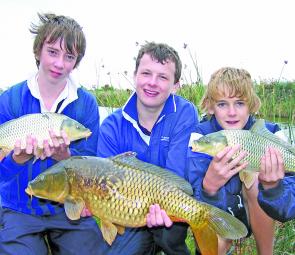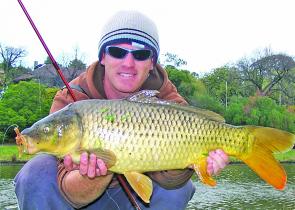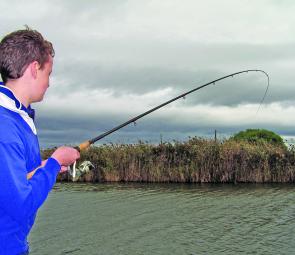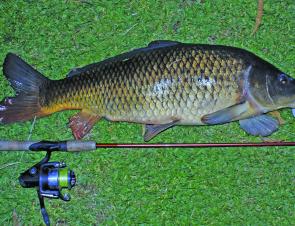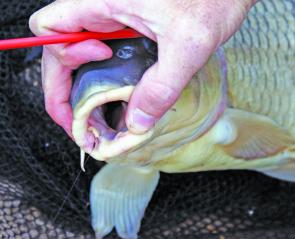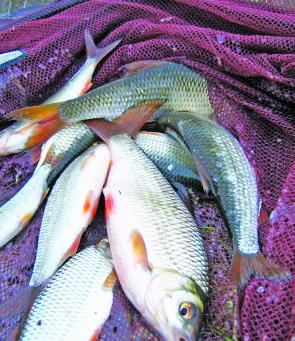Since their release into Australian waterways back in the 19th and 20th centuries, the existence and management (or perhaps mismanagement) of European carp on mainland Australia has become a highly sensitive issue.
Carp are commonly blamed for many of the problems our inland waterways have today and the very mention of the species is often the cause of heated debate. Fishing club meetings, social gatherings and more recently, internet chat forums, regularly turn into full blown arguments and slanging matches as soon as the word carp, is brought up in conversation or entered into the subject field.
It is generally accepted that the feeding habits of carp damage aquatic plant life and increase turbidity in rivers, which is believed to have impacted on native fish populations.
Whether carp have simply adapted to the conditions and taken advantage of poor habitat, or whether they are a cause of it, is subject to much debate. Some suggest that carp infested our undermined waterways in much the same way that an animal or human, with a weakened immune system, is attacked by disease.
Over time, excessive irrigation, damming, the clearing of land, pollution, and the de-snagging of rivers have all contributed to the decline of our inland waterways. Had the rivers remained healthy, Murray cod may have kept carp numbers under some sort of control.
However, prior to recent restocking initiatives, the cod themselves were struggling to survive in some areas, whereas carp have thrived. Since they can tolerate a range of water temperatures and pH levels, high salinity and polluted or poorly oxygenated water, carp have a clear advantage over native fish in degraded systems.
In addition, female carp can produce millions of eggs per year and where populations build up to high densities, they most definitely contribute to further degradation of native fish habitat.
In Victoria, carp are regarded as an invasive aquatic pest and have been declared a noxious species for quite some time. It is illegal to possess, transport or release live carp, or use carp as live bait. There is no bag or size limit and all carp must be killed, with the carcass disposed of in an appropriate manner. Regardless of your stance on carp, this should be done as quickly and humanely as possible.
If you’re not going to eat them, and let’s face it, very few do, by all means dig a hole and bury them, fertilise the garden, or perhaps feed them to your pet. Under no circumstances should any fish, carp or otherwise, be tortured, mutilated, and left to die, rot and decompose on the bank.
Controversy aside, carp can provide hours of entertainment and an opportunity for young or inexperienced anglers to develop and practice their skills. They are present in most Victorian inland rivers, lakes, dams, backwaters and some permanent drain or irrigation systems.
Carp can also be found in various urban, residential and rural ponds, some of which are heavily polluted.
Feeding carp often give themselves away by rolling on the surface, bubbling, digging at the base of reed beds, and tailing when sifting through silt in the shallows. They can also be spotted sunning themselves amongst snags, cruising in open water or causally slurping food off the surface.
Catching a few carp is by no means a difficult task. In fact, it can be downright easy during the warmer months when they are most active. Picking up fish regularly during winter, however, can be more of a challenge and often requires some thought and preparation.
As a kid, I spent many hours chasing carp using modified coarse angling techniques. Though much of the specialised equipment has become scarce in local tackle stores, there are still plenty of floats, split shot, berley cages, light lines and small chemically sharpened hooks available.
Long float rods and sensitive quiver-tips are a distinct advantage, but certainly not a necessity. A conventional spinning outfit will most definitely do the job. Hooks should be chosen in accordance with the type of bait and the size of the fish you expect to encounter. In general, size 8 to 12 hooks are ideal.
Lighter lines definitely result in more bites, but again you’ll have to take into consideration the size of the fish as well as the presence of structure. In large open water environments, skilled and patient anglers can expect to land fish that far outweigh the breaking strain of their line. Obviously some extra insurance is required when fishing closer to snags, overhanging trees, fallen timber or reed banks.
Corn, maggots, worms, bread and dough are the top baits for carp in Victoria. Small yabbies, shrimp and various other particle baits will also take fish, but if you’re after big numbers, you really can’t beat corn and maggots.
Berley also helps to draw fish into an area and keep them interested for the duration of the session. A mixture of breadcrumbs and water, combined with a few handfuls of corn kernels, maggots or chopped worms, form a berley suitable for carp. Even if you’re not getting many bites, continue to introduce a small amount on a regular basis. Carp often travel and feed in large numbers and once a school locate your free offerings, they can devour it and move on in no time.
Though rarely sought after by serious recreational anglers, carp are gradually becoming more widely recognised or perhaps tolerated, for their sport fishing attributes and willingness to intercept carefully presented lures, flies and soft plastics.
Sight casting at fish feeding in the shallows is perhaps the most effective technique. In the right hands, small worm pattern soft plastics, single tailed grubs and various critter or yabby imitations, rigged on relatively light jig-heads, can be effective. Small diving minnows and some surface presentations also account for their share of carp.
Despite various eradication campaigns, carp remain abundant in most southern waterways and it seems likely they are here to stay, at least for the time being.
Although they’re regarded a noxious pest, it’s not an offence to fish for carp, nor is it against the law to enjoy catching them.
Larger specimens pull like trains and they can provide consistent bent rod action at times, particularly in areas where natives and more desirable introduced species, such as trout and redfin, are virtually non-existent. Like them or loath them, however, all carp taken should be put to rest humanely and disposed of well away from the water.
Facts
Coarse Angling
Coarse angling is a form of freshwater bait fishing that originates in the United Kingdom. It is characterised by the use of specialised finesse tackle, where the aim is to present baits as naturally as possible.
Throughout the late 80s and early 90s, coarse angling was relatively popular in Victoria, but it soon made way for the soft plastic and light tackle lure fishing revolution. A decade of drought is also likely to have contributed to its demise.
While there may only be a handful of local anglers that practice the sport on a regular basis, modified coarse angling methods are still one of the most effective forms of fishing for introduced species, especially carp, roach, tench and goldfish.
Facts
Float Fishing
Thin pencil style floats known as wagglers or wind-beaters provide unrivalled sensitivity in terms of bite detection when fishing with small particle baits. Line is fed through the bottom end of the float and split shot is used to lock it into position. Smaller tell-tale shot can be set further down the line so only the tip of the float remains visible. Set the float at a depth that allows the bait to lay on the bottom by about 20-30cm.
Since carp are bottom feeders, the purpose of using a float is not necessarily to suspend the bait in mid water, although this may be desirable at times. In most cases, a float set up in this fashion is used purely as a highly sensitive bite indicator. After casting, tighten and sink the line between the float and your rod tip to minimise any interference caused by the wind or surface drift. When rigged correctly, even the most finicky bites can be detected.
Facts
Bottom Fishing
A quiver tip or standard spin rod, coupled with a basic running sinker or single dropper paternoster rig, is effective for presenting baits on the bottom. A small bomb style sinker or berley cage provides the weight for casting.
After making a cast, position the rod on a 45-60 angle to where the bait landed. Keep the rod horizontal to the water rather than pointing skyward. Tighten the line so that the tip is loaded. When a carp picks up the bait, quite obviously the rod tip will bend around in the direction the fish is moving. However, if a fish picks up the bait and moves towards you, the line becomes slack and the tip will straighten, at which point you should lift the rod back over your shoulder to set the hook. Once again, using this technique enables the angler to detect more bites as they take place.
Image Captions:
1.
Controversy aside, carp can provide hours of entertainment for youngsters and an opportunity for inexperienced anglers to develop and practice their skills. Like them or loath them, however, all carp taken should be put to rest humanely and disposed of well away from the water.
2.
Though they’re regarded a noxious pest, carp are gradually becoming more widely tolerated for their sport fishing attributes.
3.
A young Brad Hodges displays a carp taken on a soft plastic while prospecting the tidal reaches of Melbourne’s Yarra River for bream. Carp can tolerate relatively high levels of salinity and it’s not uncommon to encounter them in brackish rivers and estuaries.
4.
Tench are another introduced species that share similar habitat and feeding patterns to carp.
5.
Long rods and sensitive quiver-tips are a distinct advantage, but certainly not a necessity. Though much of the specialist coarse angling tackle has become scarce in local tackle stores, there are still plenty of floats, split shot, berley cages, light lines and small hooks available.
6.
With a little luck, skill and patience, carp that far outweigh the breaking strain of your line can be subdued on conventional spin outfits.
7.
Light lines and small chemically sharpened hooks, baited with either sweet corn or maggots, are a deadly combination on most introduced species.
8.
Similar techniques to those employed for carp are also effective on roach, which are prolific in some Victorian waterways, but rarely encountered by recreational anglers.
